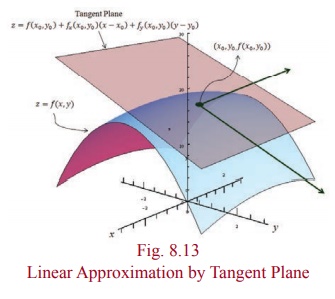Mathematics - Linear Approximation and Differential of a function of several variables | 12th Maths : UNIT 8 : Differentials and Partial Derivatives
Chapter: 12th Maths : UNIT 8 : Differentials and Partial Derivatives
Linear Approximation and Differential of a function of several variables
Linear
Approximation and Differential of a function of several variables
Earlier
in this chapter, we have seen that linear approximation and differential of a
function of one variable. Here we introduce similar ideas for functions of two
variables and three variables. In general for functions of several variables
these concepts can be defined similarly.
Definition 8.10
Let A = {( x, y ) | a
< x < b, c < y < d } ŌŖé ŌäØ2 , F : A ŌåÆ ŌäØ, and ( x0 , y0 ) Ōłł A .
(i) The linear approximation of F at ( x0 , y0
) Ōłł A is defined to be

(ii) The differential of F is defined to be

where dx = Δx and
dy = Δy,
Here we
shall outline the linear approximations and differential for the functions of
three variables. Actually, we can define linear approximations and differential
for real valued function having more variables, but we restrict ourselves to
only three variables.
Definition 8.11
Let A = {( x, y , z) | a
< x < b, c < y
< d, e < z < f } ŌŖé ŌäØ3, F : A ŌåÆ ŌäØ and ( x0 , y0 , z0
) Ōłł A .
(i) The linear approximation of F at ( x0 , y0
, z0 ) Ōłł A is defined to be

(ii) The differential of F is defined by

where dx = Δx ,
dy = Δy and dz = Δz ,
Geometrically,
in the case of function f of one
variable, the linear approximation at a point x0 represents the tangent line to the graph of y = f
( x) at x0 .
Similarly, in the case of a function F of
two variables, the linear
approximation at a point ( x0
, y0 ) represents the
tangent plane to the graph of z =
F ( x , y) at ( x0 , y0 ) .

Example 8.16
If w( x,
y , z) = x2y + y2z + z2x, x
, y, z Ōłł ŌäØ, find the differential dw.
Solution
First
let us find wx , wy , and wz .
Now wx = 2xy + z2, wy
= 2yz + x2 and wZ = 2zx + y2.
Thus,by
(15), the differential is
dw = (2xy + z2 )dx + (2 yz + x2 )dy + (2zx + y2)dz
.
Example 8.17
Let U (
x, y , z) = x 2 ŌłÆ xy + 3sin z, x , y,
z Ōłł ŌäØ. Find the linear approximation for U at (2, ŌłÆ1, 0) .
Solution
By (14),
linear approximation is given by

Now Ux = 2x ŌłÆ y , Uy = ŌłÆ x and U z = 3cos z .
Here (x0 , y0 , z0
) =
(2, ŌłÆ1,
0) , hence Ux (2, ŌłÆ1,
0) =
5, Uy (2, ŌłÆ1,
0) = ŌłÆ2
and Uz (2, ŌłÆ1,
0) =
3 .
Thus L (
x, y , z) = 6 + 5(x ŌłÆ 2) ŌłÆ 2( y + 1) + 3(z ŌłÆ 0) = 5x ŌłÆ 2 y + 3z ŌłÆ 6 is the required
Linear approximation
for U at (2, ŌłÆ1,
0) .
Related Topics